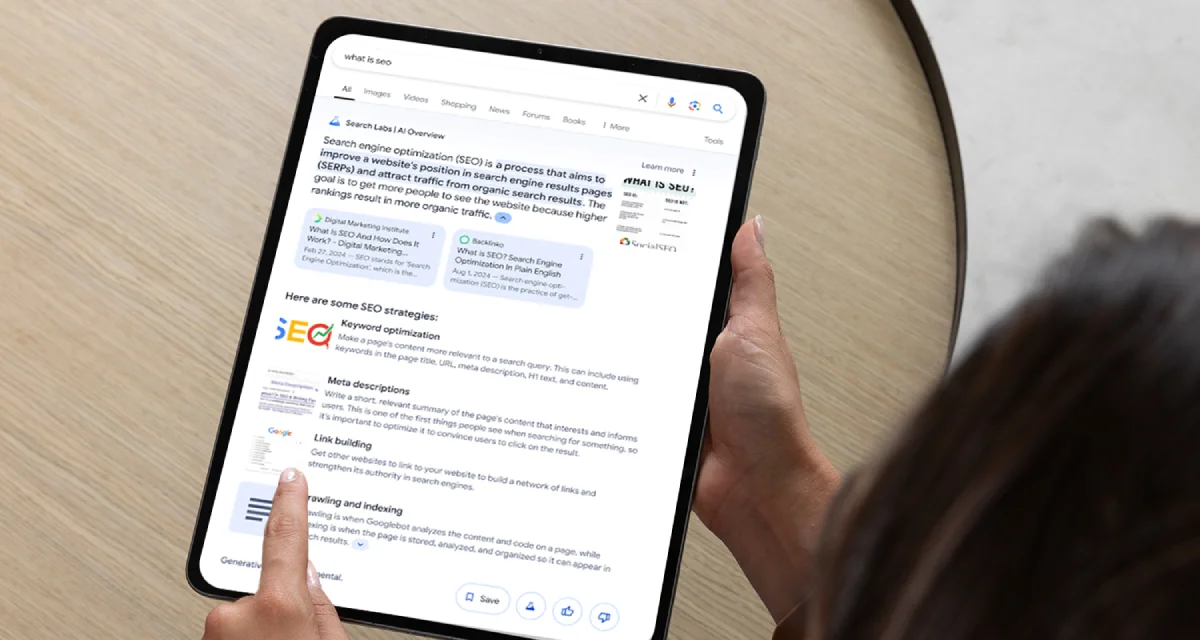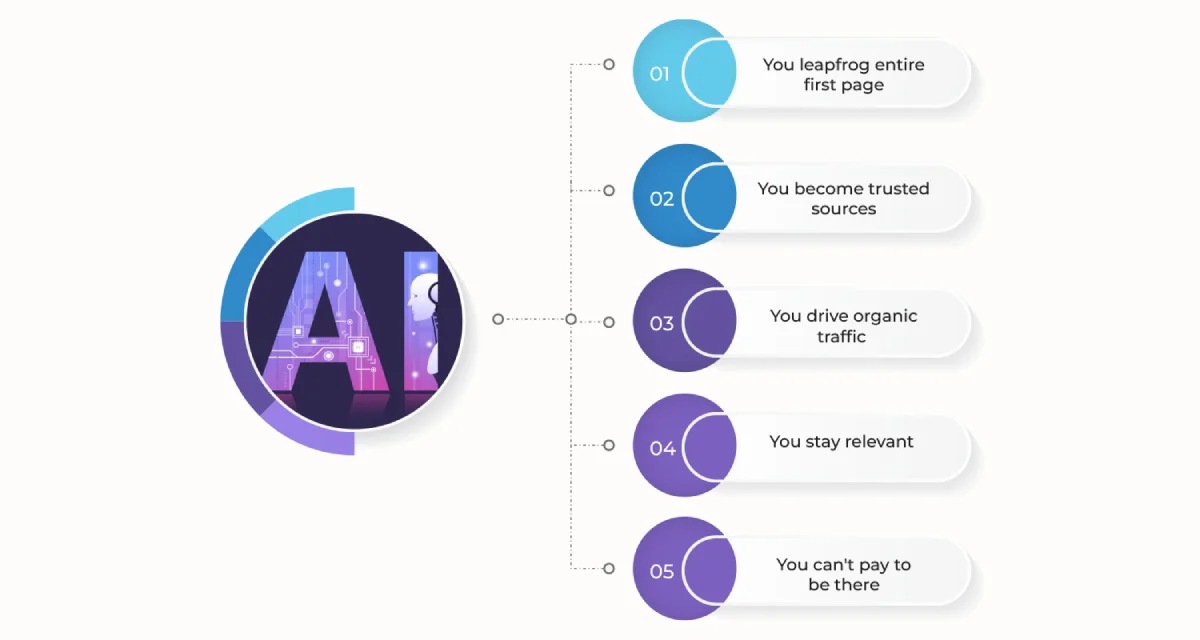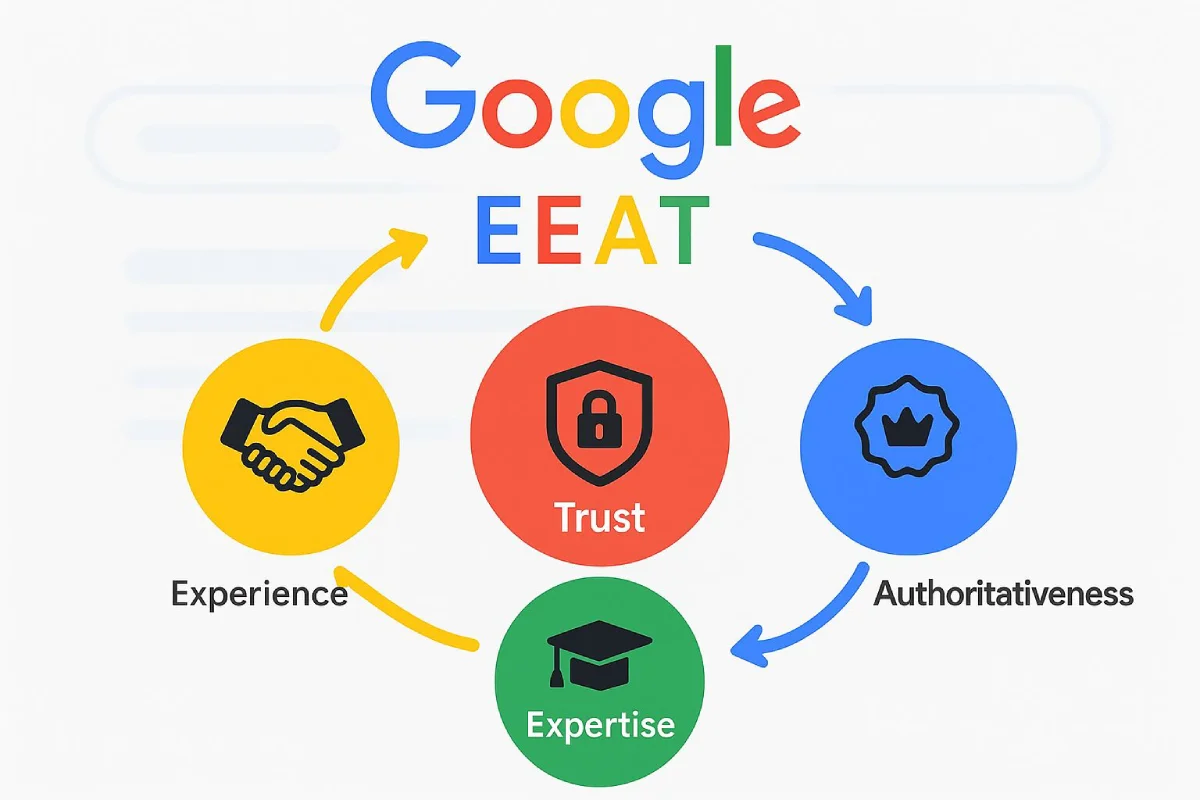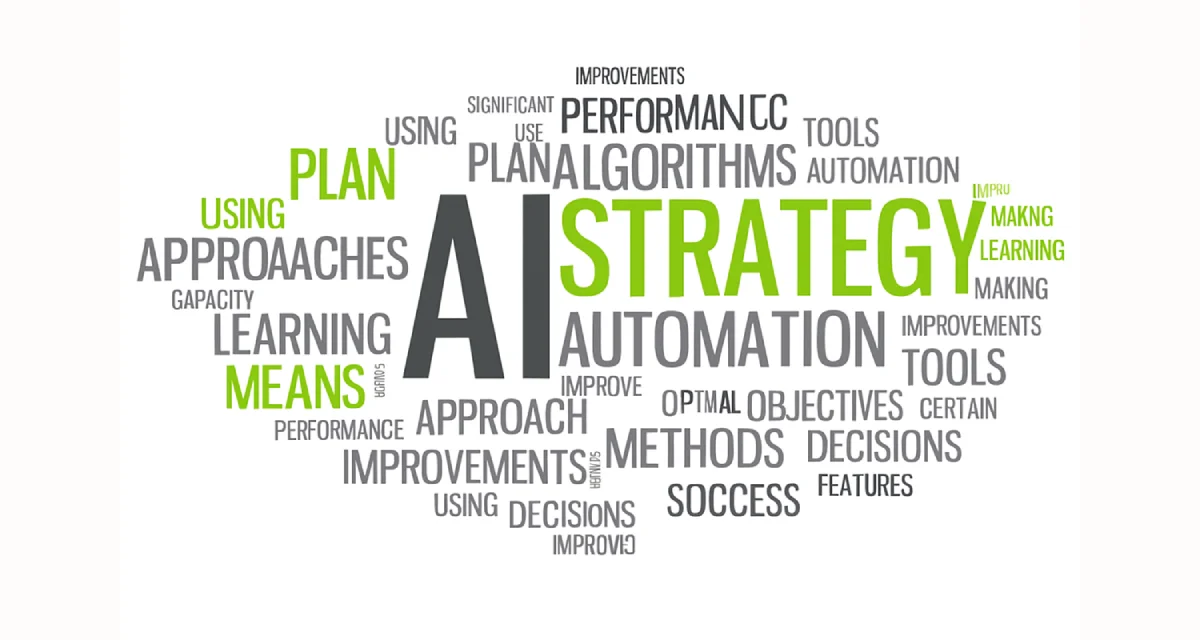
Let’s be honest, traditional search results are no longer the only battleground for visibility. In 2025, the real fight for attention is happening above the organic results, inside Google’s AI Overviews.
Yep, those AI-generated summaries that magically pop up right after you type a search query? That’s where your content needs to be. Because in an age of AI-driven search, users are getting concise answers faster than ever and if your page isn’t featured there, you’re invisible.
So the question is:
- How do you rank in AI Overview?
- How does Google decide which content appears in those AI-generated responses?
- How do you optimize your SEO strategy to show up in this new, evolving part of the Google Search landscape?
This isn’t just about showing up in search anymore. It’s about appearing in AI Overviews with valuable content that accurately answers user questions. If you’re serious about dominating these results, partnering with the best SEO company in Kerala can give you the expertise and strategies to make it happen.
In this guide, we’ll break down exactly:
- What AI Overview is and how it’s different from featured snippets
- How to tailor your content to rank in Google AI Overviews
- The ranking factors you should care about in 2025
- Actionable tips to make your content more likely to show up in these AI search results
Let’s dive into the SEO strategies that can actually get your content noticed in this new Search Generative Experience.
What Exactly Is Google’s AI Overview?

So, you just saw what a real AI Overview looks like, right at the top of a Google Search results page.
That prominent box? It’s not a featured snippet. It’s something bigger.
This is Google’s AI-generated summary, part of its evolving Search Generative Experience (SGE). It pulls from top third-party sites, guides, forums, and articles, then crafts a clean, concise answer using generative AI. Think of it as a personal assistant that does the Googling for you.
And here’s the twist:
- It shows up before traditional search results.
- It often blends in YouTube videos, Google Shopping Graph cards, or even how-to guides.
- It doesn’t just rank one site, it pulls content from multiple sources that meet the query’s search intent.
Let’s look at exactly what’s going on.
What’s Actually Happening in Image given above?
Let’s unpack that picture step by step:
- A direct answer to the user’s query, in natural, easy-to-read language
- Hyperlinked citations pointing to external sources Google trusts
- Visual elements like images or video thumbnails (depending on the topic)
- Placement above featured snippets and traditional organic results
If your content appears here, congrats, you’ve just leapfrogged everyone on the first page.
Google’s AI decides which pages deserve to be summarized, based on content quality, relevance, structured data, and on-page SEO signals. If you want to be part of that AI-generated response, your content needs to be strategically optimized and up to date.
Why Ranking in AI Overview Matters in 2025

Showing up in Google’s AI Overview isn’t just another vanity metric, it’s the new gold standard of visibility.
In 2025, user behavior has shifted. People want fast, trustworthy answers without having to scroll through ten blue links. And that’s exactly what AI Overviews deliver.
Here’s why ranking in that coveted box matters more than ever:
1. You Leapfrog the Entire First Page
This isn’t about ranking #1 anymore, it's about ranking before #1.
Appearing in the AI Overview means you’re featured above featured snippets, ads, video results, and all traditional organic listings. It's literally position zero on steroids.
2. You Become the Trusted Source
Google’s generative AI only pulls from content it trusts. If your content is selected, it signals to users that Google considers your page highly credible and valuable.
That means more brand authority, higher click-through rates, and long-term reputation wins.
3. You Drive More Qualified Organic Traffic
Because the AI Overview responds to intent-driven queries (especially informational and transactional ones), users who click through are often closer to conversion.
So whether you want sales, signups, or traffic, ranking here brings in the right audience.
4. You Stay Relevant as Search Evolves
Search is changing. Traditional blue-link SEO is no longer enough.
Ranking in AI Overviews ensures your content stays visible in Google’s evolving search landscape across devices, voice search, and even future SGE rollouts.
5. You Can’t Pay to Be There
That’s the kicker: AI Overviews can’t be gamed with ads.
You can’t bid your way to the top. The only way to show up is to earn your spot through smart, strategic SEO built around quality content and helpful signals.
If you’re ignoring AI Overviews in your SEO strategy for 2025, you’re leaving massive visibility (and revenue) on the table.
How to Structure Content for AI Overview Inclusion and Actually Get Picked
So you’ve seen the AI Overview. You understand why ranking there is a big deal. But now comes the million-dollar question:
What actually helps your content rank in AI Overviews?
Let’s be real, ranking in AI Overviews isn’t about writing another generic blog post and hoping Google throws you a bone.
In 2025, it’s about creating structured, relevant, and insanely helpful content that speaks directly to user intent and doing it in a way that Google’s AI can quickly understand, summarize, and showcase.
So, how do you actually do that? Here’s the breakdown:
1. Start With a Clear, Keyword-Rich Question (and Answer It Fast)
Think like the user. If someone searches “how to rank in AI Overview” or “what is Google AI Overview”, don’t bury the answer under fluff.
Give a concise, natural-language answer right at the top, preferably in a bullet point or short paragraph format. That’s what AI-generated summaries love. It’s all about direct answers and accurately answering search queries.
2. Use Structured Data & Schema Markup
Structured data isn’t optional anymore, it’s essential.
Add FAQ, How-To, Article, and Product schema wherever relevant. It helps Google understand the context of your page and boosts chances of showing up in AI-generated responses, featured snippets, and even local business results.
3. Organize With Clear Headers and Bullet Points
AI Overviews are obsessed with clarity. Use H2s and H3s to break down your content.
Add bullet points where possible, especially when summarizing steps, benefits, or features. This makes it easier for Google’s large language models to pull quick highlights into the Overview box.
4. Go Deep, But Keep It Scannable
Your content should be comprehensive and valuable but avoid overwhelming readers. Use short paragraphs, internal links, and “Further Reading” sections to guide deeper exploration.
High user engagement and time-on-page are positive signals for inclusion in AI search results and search generative experiences.
5. Use Clear Language + Natural Flow
Remember, AI-generated content thrives on natural language.
Don’t overoptimize. Instead, focus on writing like you’re answering a smart friend’s question, clearly, helpfully, and confidently.
6. Optimize for Mobile + Speed
AI Overviews don’t care how great your content is if your page takes forever to load.
Page speed and mobile optimization are baseline requirements. Use tools like Search Console and Google Analytics to monitor performance and fix bottlenecks.
7. Regularly Update and Refine
Stay up to date. AI-driven search is evolving fast.
Refresh stats, update screenshots, and revise copy to match current search behaviors. It shows Google your content is relevant and worth pulling into AI overviews.
AI Overviews are especially likely to feature content that answers informational searches, so include how-to guides, definitions, and explainer sections that align with search intent.
This is the new SEO battlefield. If you want your content to appear above the fold, in that coveted AI Overview real estate, you need to optimize not just for humans or bots, but for both, through structured, well-crafted, intent-driven content.
And hey, don’t forget to track your Overview rankings. Use SEO tools that monitor AI Overview inclusion, SERP rankings, and your organic traffic shifts.
E-E-A-T in the Age of AI: Still a Big Deal

In a world where AI-generated answers are dominating the top of search results, Google’s E-E-A-T framework (Experience, Expertise, Authoritativeness, and Trustworthiness) is more relevant than ever. AI Overviews don’t just pull content blindly, they synthesize answers from sources that consistently demonstrate credibility.
If your content lacks E-E-A-T signals, you risk being left out of the AI summary entirely.
Why It Still Matters:
- Experience: AI is trained to identify content that reflects real, hands-on experience, especially in YMYL (Your Money, Your Life) niches like health, law, and finance.
- Expertise: Subject matter experts are prioritized. Authorship matters. AI often includes content with a clear author profile or credentials.
- Authoritativeness: High-quality backlinks, brand mentions, and citations help your content appear as a trusted authority.
- Trustworthiness: Secure websites, factual accuracy, clear privacy policies, and transparency boost your trust signals not just for users, but for AI algorithms too.
How to Strengthen Your E-E-A-T:
- Add author bios with credentials.
- Publish first-hand case studies, tutorials, or original research.
- Show social proof, reviews, testimonials, client results.
- Keep your content up to date and fact-checked.
- Build quality backlinks and focus on being cited by other experts in your niche.
Google's AI systems pull from pages that consistently score well on quality signals, so investing in E-E-A-T now gives you compounding visibility benefits in both AI Overviews and traditional search.
Keyword Strategy for AI Overviews (Not Just Traditional SEO)

Ranking in AI Overviews isn’t about traditional keyword stuffing anymore. It’s about understanding how Google’s AI overviews, search intent, and structured data come together.
So what should you focus on?
- Search intent keywords: Instead of obsessing over one keyword, think about what users really want to know. For example, if they’re searching “best SEO tools,” they might also want “AI-generated summaries,” comparisons, or real-time insights.
- Use supporting terms: Include related keywords naturally, like AI overviews, search engines, search results, Google search, and AI-driven search to help AI connect the dots.
- Leverage structured data: Add FAQ schema, HowTo markup, or Google Shopping graph data to give context. Structured content feeds the AI cleaner info for summaries.
- Think like Search Console: What pages are getting clicks but not ranking in overviews? Tweak those with clearer answers and tighter focus.
Optimize for people, but format for AI. Think like the AI. Answer completely, support it with smart keyword usage, and format everything for clarity.
Tools and Resources for Ranking in Google AI Overviews
Having the right SEO tools is no longer optional if you want to appear in Google AI Overviews and dominate AI search results. These platforms help you identify ranking factors, optimize your content for AI-generated summaries, and track how AI overviews affect SEO in real time.
1. Research and Keyword Analysis
- Google Search Console – See how your pages perform in Google search, track clicks, impressions, and identify keywords triggering AI overviews.
- Surfer SEO – Helps create AI Overview-friendly content by optimizing keyword usage, semantic terms, and on-page elements.
- Ahrefs – Identify search queries where competitors appear in AI search results and uncover untapped keyword opportunities.
2. Structuring and Content Optimization
- Frase.io – Generates topic outlines that match AI-generated summaries style.
- Clearscope – Ensures your copy covers all relevant terms that improve visibility in Google AI Overview results.
- ChatGPT / Gemini – Assist in drafting AI-optimized content that is concise, relevant, and structured for featured snippets and AI results.
3. Technical SEO and Site Performance
- Screaming Frog SEO Spider – Audits your site for technical SEO issues like broken links, missing meta tags, and slow loading times.
- PageSpeed Insights – Boosts site speed, a critical ranking factor for both organic search and AI search results.
- Schema Markup Generators – Add structured data that improves chances of being pulled into AI-generated summaries.
4. Tracking AI Overview Visibility
- Semrush Position Tracking – Monitors your rankings in both traditional search results and AI overviews.
- SERPWatcher by Mangools – Tracks position changes when AI overviews affect SEO visibility.
- SEOTesting.com – Tests content changes to see how they influence AI Overview rankings.
5. Visual and Media Tools
- Canva – Create original visuals that increase engagement, which can boost inclusion in AI-generated summaries.
- Lumen5 – Turn articles into videos that Google search and AI tools can index for richer results.
Use a combination of keyword research tools, technical SEO checkers, and content optimization platforms. The more you align your structure and language with Google’s AI Overview ranking factors, the higher your chances of showing up at the very top of AI search results.
Common Mistakes That Keep You Out of AI Overview

Let’s be honest, if your content isn’t showing up in Google’s AI Overview, it’s not always because Google “hates” you. Sometimes, we unknowingly shoot ourselves in the foot. Here are the big slip-ups that keep websites invisible in this new AI-driven search world:
Trying to Game the System Instead of Answering the Question
AI Overviews are built to surface clear, trustworthy answers fast. If your page is a keyword soup without actually solving the user’s query, the AI skips you.
Overcomplicating the Language
Think about how AI “reads”, it loves simple, direct sentences. If your answer is buried under corporate jargon and 500-word tangents, you’re basically telling Google, “Please find someone else.”
Not Structuring Content for AI-Friendly Snippets
Long, unbroken paragraphs? No headings? No bullet points? That’s a recipe for invisibility. AI models extract bite-sized, well-structured information, not a text wall.
Ignoring Source Credibility Signals
In 2025, Google wants receipts. No author bio, no citations, no external references? You just lost major trust points with the algorithm.
Outdated or Thin Information
AI Overviews pull from fresh, comprehensive sources. If your last update was in 2022, you’re telling Google you’re not part of the conversation anymore.
Forgetting That AI Summarizes Across Sources
If your article only repeats what everyone else is saying without adding anything unique, why would the AI choose you over 20 identical pages?
No Visual or Interactive Elements
The AI isn’t just reading, it’s looking for images, charts, and structured data that add depth to an answer. A text-only page often gets outshined.
Future Trends: Where AI Overviews Are Headed in Search
AI Overviews are just the beginning. The way search works in 2025 will feel very different from the SEO playbook we all grew up with. If you want to stay ahead, you need to know what’s coming down the road.
Here are the big trends shaping the future of AI-driven search and SEO strategy:
- Hyper-Personalized Results – Search engines won’t just show the “best” answer. They’ll show your best answer, based on your search history, preferences, location, and even past interactions with AI tools.
- Voice-First Search – With Alexa, Google Assistant, and Siri getting smarter, expect AI Overviews to adapt to spoken questions and conversational queries. If your content doesn’t sound natural when read aloud, you’ll lose visibility.
- Search Without Clicking – AI-generated summaries mean users can get their answer without ever visiting a site. That’s why brand building and content authority matter more than ever, you want your brand name to appear inside those summaries.
- Integration with Shopping & Transactions – AI Overviews will increasingly link directly to purchase options, booking systems, or service calls. Think Google Shopping Graph meets AI.
- Smarter Structured Data Usage – Expect AI to lean even more on schema markup, entity-based optimization, and Google’s Knowledge Graph to pull contextually correct answers.
- Multi-Modal Search – Search won’t be text-only. AI Overviews will combine images, video clips, and even audio snippets for richer results.
- Content Credibility Signals – Search engines will continue prioritizing E-E-A-T (Experience, Expertise, Authoritativeness, Trustworthiness) but may expand it to factor in AI-detectable authenticity signals.
The sites that thrive will be the ones that stop chasing the algorithm of the moment and start creating genuinely valuable, multi-format, and authoritative content that’s easy for both humans and AI to understand.
Frequently Asked Questions
Conclusion
Google’s AI Overviews have completely reshaped how people discover and interact with content online. They sit right at the top of search results, answering questions before users even click, which means if you’re not there, your competitors will be.
To earn that prime spot, you need more than just keywords. You need strategically structured content, clear and concise answers, strong E-E-A-T signals, and a format that Google’s AI can easily understand. Add to that a commitment to user-first value, and you’re building not just for rankings but for long-term trust.
The businesses winning today are the ones adapting quickly to these shifts, experimenting, tracking results, and staying ahead of evolving AI algorithms. And that’s where Techpullers comes in. We blend proven SEO expertise with AI-era strategies to get your brand noticed in the spaces that matter most.
The search landscape is changing faster than ever. Don’t just keep up, get ahead. Start optimizing for AI Overviews now, and secure your spot at the very top.
